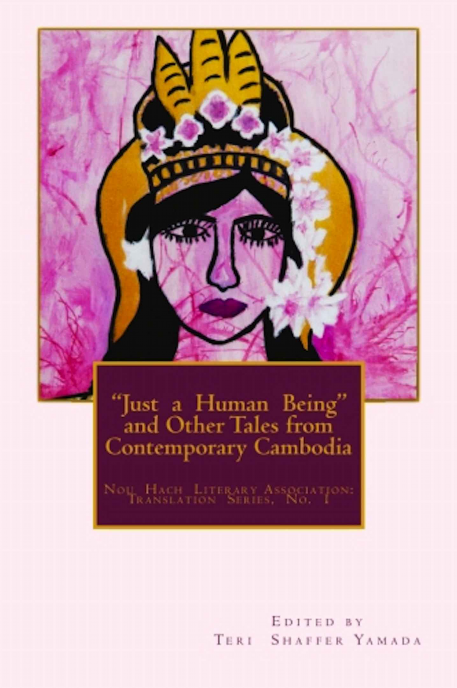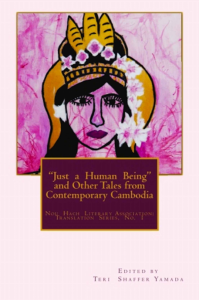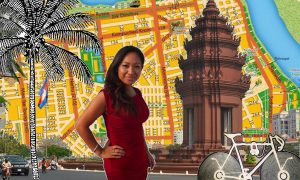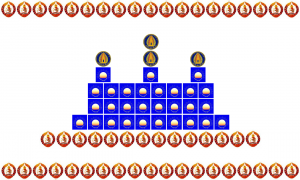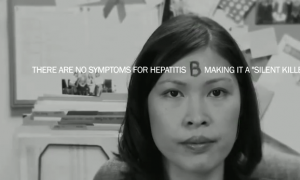American author Annie Dillard once observed that reading about war makes you realize the world is a moral arena that requires your strength. There is a struggle to be joined, a side to be chosen. Indeed, reading about modern Cambodia as a post-war society, this sentiment resonates strongly. The dozen fictional stories comprising “Just a Human Being” were written by present-day Cambodian citizens and convey a stark, somber impression of life there. Throughout, the themes are serious—the characters contemplate various ethical problems while dealing with loss, unfortunate accidents, and financial hardship. Yet at the same time, hope can be found in the emphasis on fairness and empathy for others.
One story that stands out from the rest is “The Revolver,” which is distinguished by its use of the grammatical second person, its self-reference as a would-be love story, and its ambiguous ending. The 25-year-old protagonist fleetingly tells of leaving his lover behind in Paris to move to Phnom Penh and trying to write a love story, so that the world will find a book regarding Cambodia that is not about the genocide. He struggles to write despite his belief that “love exists in the heart of every human being.” After becoming involved with a woman who is actually the mistress of a gangster, his life is spared by the gangster’s hired assassin, Sam. The nameless protagonist protests that he cannot die without writing the love story he intends.
To that end, the relationship of Sam and his wife seems to deepen the aspiring author’s convictions about love, although the wife cannot articulate her feelings for her husband (perhaps reflecting a cultural aversion to openly discussing strong intimate emotions). Most of what happens is directly stated rather than described or shown, continuously using “you” to refer to the protagonist himself. It seems a curious stylistic choice, but this form of address does influence the reader to identify more closely with him in the absence of stronger dialogue and descriptive immediacy.
At the conclusion of “The Revolver,” both the protagonist and Sam’s wife are deeply worried when Sam promises to perform one last job for the boss who originally hired him to kill the protagonist. But can the eventual outcome be written as a love story, the relieved reunion of husband and wife, or will it be an obituary for a killer turned friend? Overall, “The Revolver” does not quite manage to be a classic tale of romantic love, but it is edifying nonetheless as a realistic vignette of the unexpected results from seeking such a story. If the promise of a love story can motivate and even save the life of its wistful author, what would be the power of the fully realized book?
Other stories in “Just a Human Being” include treatments of familial/societal solidarity and compassion even for those we don’t identify with. A few are allegorical (including two in which the characters are animals), but the majority have obvious moral directives with woeful endings. The titular story, an anonymous contribution that concludes the book, is also distinctive in its format and terseness. Consisting only of a dialogue between two characters, it pointedly critiques the double standard, based on perceived social stature, of how authorities treat those they are supposed to represent and serve. An average man in distress, “just a human being” rather than a higher-up, is refused a meeting by a chief and his assistant, who never even bother to wonder what the cause of the man’s weeping is. Instead, the two decide it unnecessary to straighten up the office and return to their normal state of cavalier indifference.
Instead of looking away from such scenes of pain and struggle, readers of “Just a Human Being” are tacitly asked to face the rawness and salvage something. Whether they are able to do so may depend on their own concern for the fates of strangers. Undoubtedly, some of the writing has rough edges, though that could very well be partly due to the unavoidable difficulties of translation. Naturally, the writers vary in their skill and experience with storytelling, making the collection perhaps a bit uneven when considered as a whole. But all are to be commended for contributing to Cambodia’s literary culture, which remains underdeveloped, as Cal State Long Beach professor Teri Yamada, the book’s editor, explains in its epilogue.
These fictionalized accounts echo the many memoirs that have been published by survivors among the Cambodian diaspora. However, the brevity and creativity of the short story format makes for a poignant look at current conditions rather than historical recollections in a nation that is redeveloping itself. Another positive sign is the writers’ ability to create a record of their voices and share it more widely, thanks to renewed interest in and support of the arts in Cambodia.
*
Khmerican also discussed the book further with Dr. Yamada, including her own experiences, the state of Cambodian literature, and the events that led to this new publication.
Khmerican: What first sparked your interest in Southeast Asian literature?
Yamada: I am one of the first to graduate with a bachelor’s in Asian Studies in the UC system, from the program in Asian Studies from UC Santa Barbara in 1975. There was one course in Southeast Asia at that time and I became fascinated in an area that always seems to be left in courses and textbooks on “Asia.” When I returned from living in Japan for many years and got a job as a lecturer at CSULB in 1988, I became interested in the neighboring Cambodian community.
I began to lobby for a Khmer heritage language course and part of that task was to find out what literature there might be to read in that course. From there I began to research modern Cambodian literature and especially the short story genre. I became interested in the entire region and its modern short story as part of nationalism and modernization.
This lead to “Virtual Lotus: Modern Fiction of Southeast Asia” (University of Michigan Press, 2002), the first comprehensive collection of modern short fiction in English translation from Southeast Asia and its companion volume “Modern Short Fiction of Southeast Asia: A Literary History” (Association for Asian Studies, 2009).
Your previous two books were also edited compilations. How has “Just a Human Being” evolved from those efforts? What new challenges or rewards were there in producing this latest book?
The Nou Hach Literary Association (founded 2002) came out of my concern for writers in Cambodia and the absence of any short story tradition or space for publication. We began annual literary awards, including one for short fiction. The translations for the book are from the short fiction awarded prizes (first through third place) and then published in the Nou Hach Literary Journal, volumes 1 through 6 (2004-2009). Three stories are republished from Virtual Lotus.
“‘Just a Human Being’ and Other Tales from Contemporary Cambodia” was a ten-year project. There are very few excellent translators of Cambodian literature worldwide. To compensate, we formed a translation team of highly educated Cambodians with bachelor’s degrees in Khmer literature from the Royal University of Phnom Penh and myself with some knowledge of written Khmer and good English skills. It was a long and tedious process involving five people in the end. We would do one or two translations each year.
We have published this collection as a fundraising effort for the Nou Hach Literary Association. All the royalties go to support the annual writers’ conference in Phnom Penh. Due to the problem of pirating of books in Cambodia, we have been unable to use the journal as a fundraising means for the association. The reward is the publication of the first collection of Cambodian short fiction in English translation.
You’ve noted that socially critical short fiction is an emerging genre in Cambodia. Why is that, and what have been the most prevalent genres historically versus today?
It is probably more accurate to say a “re-emerging tradition.” Both Nou Hach (1950s) and Soth Polin (1960s) wrote socially critical fiction, but Soth Polin was forced to leave Cambodia. The golden age of modern Cambodian literature was from the 1940s to early 1950s with writers like Nou Hach. There were a number of literary journals published at that time allowing a place for publishing short fiction; newspapers also published short fiction.
Cambodian writers, especially since the late 1950s, have experienced various degrees of state censorship on freedom of expression. So it was difficult to publish socially critical fiction or essays, often interpreted as a critique of those in power from the 1950s onward leading to a thematic emphasis on romance and detective fiction in the novella form most popular in Cambodia. Some were braver, experimental writers like Soth Polin.
Then, the Khmer Rouge era (1975-9) caused the disappearance of most writers and intellectuals; then the imposition of social realism, another form of censorship, occurred under the People’s Republic of Kampuchea (PRK), 1979-89. The democratic elections under the United Nations Transitional Authority in Cambodia (1992-3) ushered in a new era of open literary expression through the many newspapers published during the 1990s. This openness would gradually change from the 2000s as the government again imposed censorship laws on journalists.
Since the reading-for-pleasure public in Cambodia is still small, writers self-publish their works unable to make much money from them. There are a few exceptions, especially writers who can leverage their ability to write film scripts now. The romance novella remains the most popular literary form since it has been from the first novella Kim Hak’s Tik Tonlesap (Waters of the Tonlesap, 1939).
Is there anything that distinguishes Cambodian writers from their counterparts in the region, whether thematically, tonally, or otherwise?
The short story genre has yet to be established in Cambodia unlike the rest of Southeast Asia. The focus on “traditional modern” literature in the public schools, including the public universities—Tum Teav and Nou Hach’s works, for example—do not support a change in reading among the literate public. Also there is still no form of literary criticism or book review genre in Cambodia. It would be helpful to have a short version of the New York Review of Books so that readers would know what is recently published.
It is difficult for Cambodian writers to engage in a writing process of repeated rewrite in order to shape the plot and focus on more compelling character development. There are no creative writing classes or programs in the universities like here in the United States. It is difficult in Cambodia to learn how to write a well-developed short story. And little reason to engage in that effort if no one reads the final product since it is difficult to place in a newspaper or magazine.
Current short fiction writers are concerned with injustices in contemporary Cambodia society, especially the gap between rich and poor, urban and rural life. Common themes are a return to Buddhist compassion for Cambodians who struggle to survive—the rickshaw pullers, poor fishermen, rural young men come to school in Phnom Penh in a contemporary competitive capitalist economy within Cambodia. Some Cambodian writers still enjoy writing animal tales albeit in a modern context. This is no longer common in the rest of Asia.
Please explain the mission of the Nou Hach Literary Journal, which will receive all proceeds from sales of this book.
Check the website at NouHachJournal.net for lots of information. This is from “About Us”:
The Nou Hach Literary Project was initiated in 2002 with the objective of supporting the development of modern Cambodian literature, which has yet to recover from the excesses of the Khmer Rouge era. We annually publish a literary journal and hold a writers conference with speakers and literary awards to honor and support modern writers in Cambodia. Underlying this effort has been the intent to foster greater literacy and to develop the intellectual infrastructure in civil society. We sponsor creative writing workshops at schools of pedagogy in the outlying provinces and disseminate the Nou Hach Literary Journal to high school teachers to fill these two objectives. We have an apolitical, inclusive policy as advocates for freedom of literary expression.
If you could recommend just one book or author to young Cambodian Americans, what or who would that be?
I would recommend Bree Lafreniere and Daran Kravanh’s “Music through the Dark: A Tale of Survival in Cambodia” because it is very well written and explains the complexity of the Khmer Rouge experience that would enable young Cambodian’s to better relate to their parents and grandparents. We are waiting for this generation of young Cambodians to become the writers of a new experience.
What do you see as the value of Asian and Asian American studies and their literatures in the face of the current emphasis on science, technology, engineering, and math as the most important disciplines for our society’s future?
Public universities across the U.S. are struggling to preserve departments of literature and ethnic studies. Since Long Beach has the largest population of Cambodian youth in a university, and a large population of Asian American youth, it seems simply unacceptable to do away with Asian American Studies here. That Asian Studies would be under threat seems ridiculous, given the importance of Asia in the new global economy.
But, we are a small department and the university administration is driven now by the number of majors a department has, not by its relevance to a broader good to the university and surrounding community. If we look at what business wants from our graduates, it is those skills we teach in the liberal arts, including Asian and Asian American Studies: written and oral communication skills, the ability to solve problems through group projects, higher order computer skills such as critical thinking using discussion boards so that students get used to project development in an all online environment. See my latest blog post at Restructuring Public Hi Ed.
You’ve formed close personal and professional ties to the Cambodian community through many dedicated years of teaching/advising, travel, and civic involvement. Could you share a memorable moment that you’re proud of? What has kept you going despite frustrations or sacrifices?
Probably the most meaningful part of my academic career at CSULB has been faculty mentor of the Cambodian Student Society. So many of the officers have gone on to be successful professionals in a wide array of disciplines: banking, education, social work, engineer, professor of English, entrepreneur and so forth. I have seen so much success from these Cambodian Americans coming from less than optimal life circumstances.
I also focus on the development of young writers in Cambodia so it is very interesting for me to experience the life and struggles of college-level Cambodian youth both in Long Beach and Phnom Penh. The fact that what I do may make a positive difference for others is what keeps me going. A memorial moment was when the Nou Hach Literary project and was named in 2008 as the winner of the Jeri Laber International Freedom to Publish Award.
What do you hope to accomplish next?
Next volume for the Nou Hach Literary Association is a bilingual collection of award-winning poetry.


